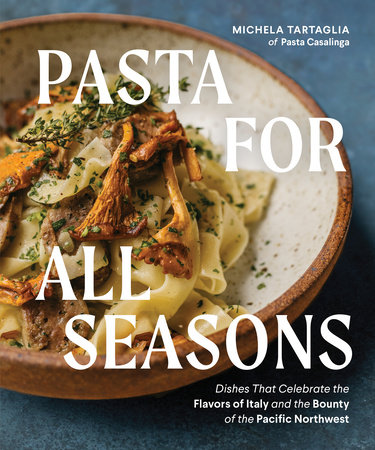Pasta for Every Season Pasta every day. Pasta in all its glorious forms, textures, and shapes. Pasta for your body, pasta for your brain, but, really, it’s about pasta for your
soul. Per capita, Italians eat an average of sixty-two pounds of pasta annually, which means tucking into a plate of pasta goodness three to four times a week. We eat it mainly for lunch, but it’s certainly on the menu for dinner as well. It’s a national point of pride, “an icon of Italian cooking” (says Massimo Montanari in
A Short History of Spaghetti with Tomato Sauce), and something that we could never give up. And why would we want to?
Not to sound dramatic, but I literally cannot imagine my life without a bowl of pasta in it. It’s never boring because when you add fresh, seasonal ingredients, the possibilities (pasta-bilities?) are limitless.
Don’t get me wrong. You can have an excellent pasta, but with a lackluster or pedestrian sauce, your dish is ruined. Or you can cook a wonderful sauce, but combined with a poor-quality pata, the result will be subpar.
This small but mighty publication is unmistakably a pasta book, but the fresh ingredients—particularly ingredients from the Pacific Northwest (or PNW, as we affectionately call it)—are the stars of the show.
When we opened Pasta Casalinga in Pike Place Market, we wanted to focus on fresh pasta making, crafted in small batches, created with quality flour and perfectly cooked al dente. And we wanted to lean into local and seasonal ingredients, from the stinging nettles that appear on the Olympic Peninsula during springtime to the Pacific golden chanterelles in the fall.
Here, you will find my favorite local ingredients paired with pasta. The chapters are organized by season and the recipes are labeled with icons to indicate whether they are
from the ocean (featuring seafood),
from the farm (featuring raised meats), or
from the garden (all vegetarian). In other words, there is a pasta option for everyone.
Cooking seasonally and, therefore, eating seasonally has always been the only choice in my family. I grew up in a small town near Turin in the Piedmont region of Italy before globalization, which meant having asparagus exclusively in the spring and green beans only in the summertime. I am grateful for my upbringing because I learned the importance of knowing where your food comes from and when it is available. For me, that translates into refusing to eat certain foods at certain times of the year. Asparagus in December? Inconceivable!
The dishes here are not secret family recipes, which often seems to be the thing that’s valued when talking about Italian cooking. Is it my
nonna’s recipe? Is it going to taste like it came from the streets of Naples? Sometimes yes but mostly no. Infused with my Italian sensibilities, culture, and training, these recipes are a tribute to the PNW and combine classic flavors with creative twists designed to showcase the local bounty. Italian through and through, I am a pasta lover who is continually inspired to cook with the seasons. I hope that they can encourage you to let the ingredients be your guide when cooking and to find many ways to incorporate fresh produce, seafood, and meats into pasta dishes. It’s the best way to feed your soul.
Sample recipe from Spring:
Gigli con pesto di ortiche e noci, ricotta salata e olio di peperoncino calabrese / Gigli with Olympic Peninsula Stinging Nettle and Walnut Pesto, Ricotta Salata, and Calabrian Chili Oil Ortiche—or nettles—are unquestionably a sign of spring in the Pacific Northwest. This gorgeous region has a bounty of nettles ready to be harvested usually starting in April, when the plants are still young and tender. Hiking to a secret spot to forage nettles is a quintessential local activity, although it is common to find wild nettles in the backyards of many houses on the Olympic Peninsula and surrounding areas. Searching for nettles brings back memories of when I was a young kid in Italy: I used to go foraging with my
nonna behind the little wine cellar we had at the farm. There were so many nettles waiting to be picked, processed, and cooked in a frittata religiously made with fresh brown eggs. Here, I’ve developed a nettle pesto recipe that incorporates what should be a must-have seasonal condiment for anyone living in the PNW.
Makes 4 servings
3 to 4 ounces young stinging nettles
1/2 cup raw walnuts
1/2 cup extra-virgin olive oil
1/2 cup grated Parmigiano-Reggiano
Kosher salt and freshly ground black pepper
12 ounces gigli pasta
1/3 cup grated ricotta salata
2 tablespoons Calabrian chili oil
8 to 10 edible spring flowers
Bring a large pot of salted water to a boil. In the meantime, put on gloves and clean the nettles, removing the stems and keeping just the leaves. Rinse the leaves, then blanch them in the boiling water for less than a minute. Cool them down under cold water or in an ice bath.
When the nettles are cool, drain them, making sure to remove the excess water. In a food processor on low speed, blend the nettles, walnuts, olive oil, and Parmigiano, until the pesto is creamy, but not liquified (it should still have some texture). Season with salt and pepper to taste.
Meanwhile, in a large pot of boiling salted water, cook the gigli until al dente and drain. In a medium pan over medium heat, quickly sauté the pasta and pesto for 1 minute, adding pasta water as necessary to bind the ingredients.
Plate in four bowls. Finish with the grated ricotta salata, a drizzle of Calabrian chili oil, and a couple of edible flowers. Enjoy the spring season on a plate.
Tips: Be sure to wear gloves to avoid being stung by the nettles. Blanching them is a necessary step to neutralize the stinging part.
If you have access to a good amount of nettles, you can prepare a lot of pesto in jars, and store them in the fridge for up to 5 days or freeze for a couple of months. Just make sure to cover up the pesto in each jar with a drizzle of extra-virgin olive oil to prevent oxidation.
Copyright © 2023 by Tartaglia, Michela. All rights reserved. No part of this excerpt may be reproduced or reprinted without permission in writing from the publisher.


















